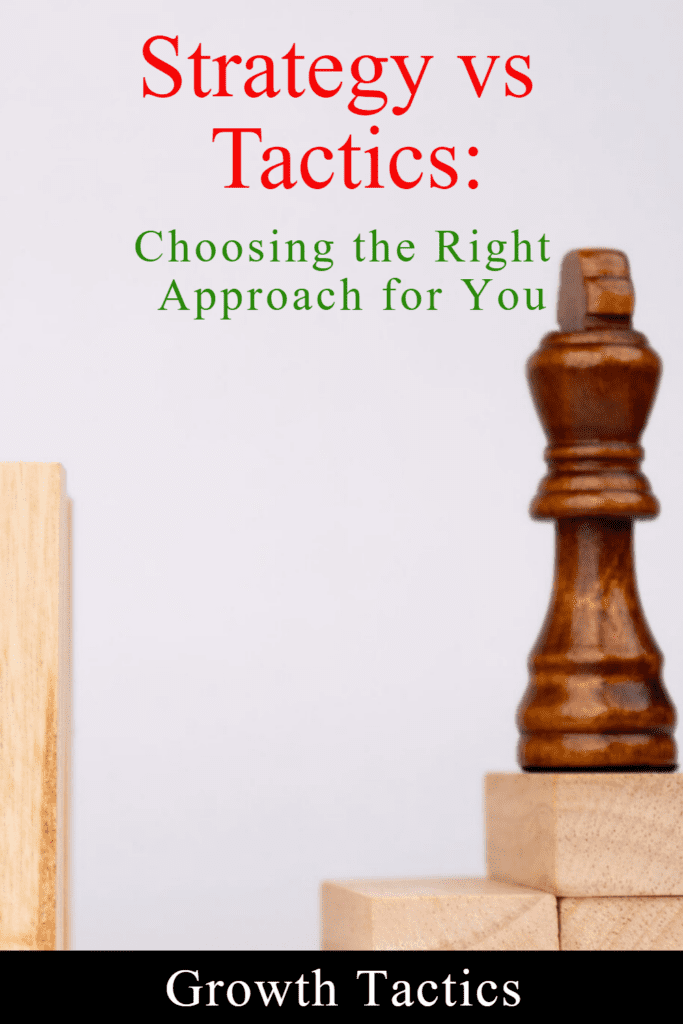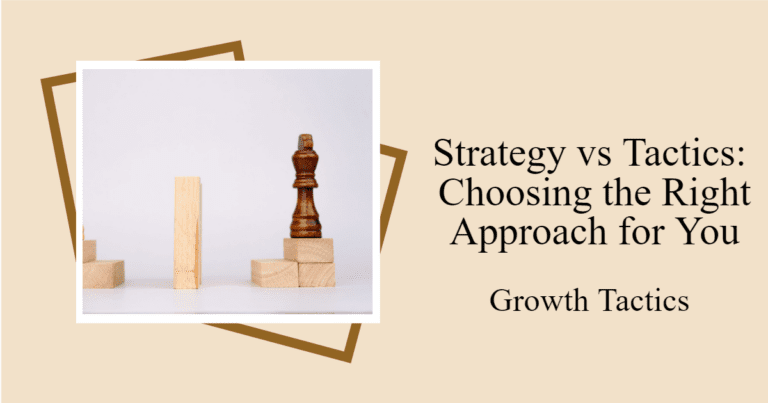Have you ever felt lost in the daily hustle, wondering if you’re moving toward your big dreams? I know I have. There was a time when I was so caught up in my to-do list that I lost sight of my bigger goals. That’s when I learned about the power of understanding strategy vs tactics. This knowledge changed the game for me, and I bet it can for you too.
Jump To Section
What is Strategy?

Strategy is your game plan for success. It’s the big-picture thinking that guides your actions. I used to struggle with this concept until I realized it’s like planning a road trip. You need to know where you’re going before you start driving, right?
Strategy is crucial because it gives you direction. It helps you make smart choices about where to focus your energy. Without it, you might find yourself working hard but not getting anywhere. Trust me, I’ve been there, and it’s not fun.
Long-term goals and the big picture
When we talk about strategy, we’re talking about your long-term goals. It’s not about what you’re doing today or tomorrow. It’s about where you want to be in a year, five years, or even ten years from now.
Think about what you really want to achieve. Maybe you want to grow your business, advance in your career, or make a difference in your community. Your strategy is the roadmap that’ll get you there.
How strategic thinking shapes your path
Strategic thinking helps you see opportunities and challenges before they happen. When you think strategically, you’re not just reacting to what’s happening now. You’re planning for the future.
This kind of thinking shapes your path by helping you make better decisions. It guides where you put your time and energy. It even helps you say “no” to things that don’t fit your big goals.
I’ve seen how strategic thinking can transform lives and businesses. It’s not always easy, but it’s worth it.
So, take some time to think about your strategy. What’s your big picture? Where do you want to go? Once you have that figured out, you’ll be amazed at how much clearer your path becomes.
What are Tactics?

Tactics are the specific actions you take to achieve your goals. Think of them as the small steps that lead to big wins. I like to think of tactics as the tools in my toolbox. Each one has a specific purpose and helps me get the job done.
In my experience, tactics play a crucial role in success. They’re the difference between having a great idea and actually making it happen. Without solid tactics, even the best strategy can fall flat. I’ve seen this happen time and time again in both my personal and professional life.
Short-term actions and daily operations
Tactics are all about the here and now. They’re the tasks you do today, tomorrow, and next week. While strategy is your big-picture plan, tactics are the nitty-gritty details that make it all work.
For example, if your strategy is to grow your business, your tactics might include things like reaching out to new customers, improving your product, or streamlining your processes. These are the day-to-day actions that add up to big results over time.
I remember when I first started focusing on tactics in my own work. It was like turning on a light switch. Suddenly, I could see exactly what I needed to do each day to move closer to my goals.
The power of tactical execution
Here’s the thing about tactics: they only work if you actually do them. That’s where execution comes in.
I’ve found that the power of tactical execution lies in its ability to create momentum. When you consistently carry out your tactics, you start to see results. Those results motivate you to keep going, which leads to even more results. It’s a positive cycle that can really drive your success.
Don’t be afraid to try different approaches until you find what fits. The key is to keep moving forward, one tactical step at a time.
Strategy vs Tactics: Key Differences

Time frame: Long-term vs short-term
When I think about strategy and tactics, I often use the analogy of planning a road trip. Strategy is like deciding on your final destination and the route you’ll take. Tactics are the day-to-day decisions you make along the way, like where to stop for gas or which local diner to try for lunch.
Strategies typically look far into the future. They’re your big plans that might take months or even years to achieve. Tactics, on the other hand, are more immediate. They’re the actions you take today, tomorrow, or next week to move towards your strategic goals.
I’ve found that balancing both is crucial. Without a long-term strategy, you might find yourself busy with tactics but not really getting anywhere meaningful.
Scope: Big picture vs specific actions
Think of strategy as your bird’s-eye view of the landscape. It’s the big picture that helps you understand where you are and where you want to go. Tactics are more like the individual steps you take on the ground to navigate that landscape.
In my experience, a good strategy gives you a clear vision of what you want to achieve. Tactics are the specific, concrete actions you take to make that vision a reality.
For example, if your strategy is to become a leader in your industry, your tactics might include things like networking at industry events, improving your skills through training, or mentoring junior colleagues.
Focus: Direction vs implementation
Strategy sets your direction. It’s like a compass that keeps you pointed toward your ultimate goal. Tactics, however, are all about implementation. They’re the actual steps you take to move in that direction.
I once worked with a team that had a brilliant strategy but struggled with tactics. They knew where they wanted to go but couldn’t figure out how to get there. We had to break down their big goals into smaller, actionable steps. Once we did that, everything started falling into place.
The Planning Process: Bringing Strategy and Tactics Together

Setting clear business objectives
You need to know where you’re going before you can figure out how to get there. Start by asking yourself, “What do I really want to achieve?” Be specific and write it down. I always encourage my mentees to dream big but stay realistic.
Developing your strategic plan
Once you know your objectives, it’s time to map out your route. This is your strategic plan. I like to think of it as the GPS for your business journey. It doesn’t show every turn, but it gives you the big picture of how to reach your destination. Remember, your strategy should be flexible. I’ve had to change my own strategies many times when faced with unexpected challenges.
Creating tactical action steps
Now, let’s break that big journey into smaller steps. These are your tactics. The daily actions that move you forward. I find it helpful to ask, “What can I do today to get closer to my goal?” Make your tactics specific and achievable. For example, if your strategy is to grow your customer base, a tactic might be to make five new customer calls each day.
Real-World Applications

Military strategy and tactics
The military is where I first learned about strategy and tactics. In the field, strategy might be the overall plan to win the war, while tactics are the individual maneuvers used in each battle. Just like in business, both are crucial for success.
Business strategy and operational-level decisions
In the business world, I’ve seen how strategy guides big decisions like entering new markets or launching new products. Tactics show up in day-to-day operations, like how to improve customer service or streamline production. Both need to work together for a business to thrive.
Personal growth and problem-solving
I use strategy and tactics in my personal life too. My strategy might be to improve my health, while my tactics include eating more vegetables and exercising regularly. When solving problems, I first think strategically about the best approach, then use tactics to implement my solution step by step.
Developing Your Strategic and Tactical Skills
Cultivating strategic thinking
To think more strategically, I practice looking at the big picture. I ask myself, “Where do I want to be in five years?” and “What are the major trends affecting my industry?” Reading widely and talking to people with different perspectives has also helped me become a better strategic thinker.
Honing your tactical execution
Getting better at tactics is all about practice and learning from experience. I try to set small, achievable goals and track my progress. When things don’t work out, I ask myself why and adjust my approach. Remember, it’s okay to make mistakes. That’s how we learn and improve.
Balancing both for optimal decision-making
The real magic happens when you can balance strategy and tactics. I’ve found that the best decisions consider both the long-term vision and the immediate actions needed. It’s like being able to see the forest and the trees at the same time. Keep practicing, and you’ll get better at finding this balance in your own life and work.
Conclusion
As we wrap up, I want you to remember that understanding strategy and tactics isn’t just about business or military planning. It’s about you and your unique journey.
I’ve seen firsthand how this knowledge can transform the way we approach our goals, big and small. It’s helped me become a better leader and problem-solver, and I believe it can do the same for you.
Remember, your strategy is your compass, guiding you towards your long-term vision. Your tactics are the steps you take each day to get there. By balancing both, you’re setting yourself up for success.


